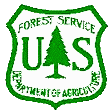
Chapter 5
Ecological Subregions of the United
States
| Back |  |  Contents |  | Forward |
 | Chapter 5 |
|
Seward Peninsula Tundra - Meadow
One section have been delineated in this Province:M125A--Seward Mountains
Located in northwestern Alaska along the Bering Sea, it includes much of the Seward Peninsula and part of St. Lawrence Island. The area of this Section is about 20,600 mi2 (53,400 km2).
Section M125A--Seward Mountains
Geomorphology. The area consists mainly of extensive uplands of broad convex hills and flat divides indented by sharp V-shaped valleys. Isolated groups of glaciated mountains and peaks cover the higher elevation areas. Elevation ranges from sea level to 4,600 ft (1,400 m).Lithology and Stratigraphy. The entire section lies within the Seward terrane that consists of metamorphosed mica and calcareous schists, marbles, gneissic, and other metavolcanic rocks of Paleozoic age.
Soil Taxa. Soils are predominantly Histic Pergelic Cryaquepts, Pergelic Cryaquepts, Typic Cryochrepts, Lithic Cryorthents, and Pergelic Cryumbrepts. Soils generally are poorly drained and shallow over permafrost. On hillslopes and ridges, soils are formed in very gravelly residual material over weathered bedrocks. At lower elevations, they are formed mainly in colluvial and alluvial sediments.
Potential Natural Vegetation. Vegetation patterns consist of moist tundra sedge-tussock meadows at lower elevations, interspersed with scattered willows, birch, and isolated spruce-hardwood forests, particularly along rivers. Alpine tundra heath meadows and barrens dominate the high mountains.
Granite talus on the slopes of Cape Mountain on the western tip of the Seward Peninsula. The village of Cape Prince of Wales is on the left.}
Fauna. Spectacled eiders, ruddy turnstones, and black turnstones are common breeding birds in the lowland tundra portions of this Section. The rare Arctic loon, which breeds only in western Alaska, is characteristic of this area. Yellow wagtails inhabit willow thickets on the tundra, and white wagtails nest in open areas along the coast. The only known breeding grounds of the very rare bristle-thighed curlew extend through this Section. Arctic foxes and Alaskan hares are common; polar bears are often observed. Ribbon seals are characteristic of off-shore areas. Reindeer were introduced from 1891 to 1902 to provide an additional food source for the resident human population. Musk oxen were introduced in 1970 as a potential game animal. Chum salmon are the most numerous of the five salmon species in this area. Sheefish and Arctic char are common in near-shore saltwater and in area streams.
Climate. Average annual precipitation ranges from 10 to 16 in (250 to 400 mm). Average annual temperature ranges from 21 to 26 _o_F (-6 to -3 _o_C). The growing season is approximately from June 1 to September 15.
Surface Water Characteristics. Streams occupy all the larger valleys. Many inland lakes and small coastal lakes and ponds exist. Most of the area is underlain by permafrost. Wetlands occupy 53 percent of the area.
Disturbance Regimes. Occurrence of wildfires is common, particularly from June through August. Mosses and lichens dry during summer, allowing fire to spread through the tundra.
Land Use. Population is low and dispersed. The largest settlement is Nome, where subsistence and recreational hunting and fishing are concentrated. Numerous mines are scattered throughout the section.
Cultural Ecology. This is the historic range of Inupiaq Eskimos.
Compiled by Alaska Region.
Top
Back
ContentsForward